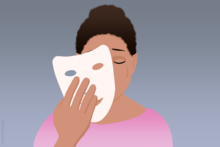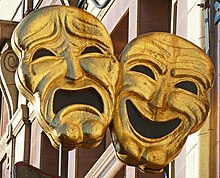Masking (personality)
This entire article needs additional citations for verification. (September 2022) |

Masking in psychology and sociology is the process in which an individual "masks" or camouflages their natural personality or behavior to conform to social pressures, abuse or harassment. Masking can be strongly influenced by environmental factors such as authoritarian parents, rejection, and emotional, physical, or sexual abuse. Masking can be a behavior individuals adopt subconsciously as coping mechanisms or a trauma responses, or it can be a conscious behavior an individual adopts to fit in within perceived societal norms. Masking is interconnected with maintaining performative behavior within social structures and cultures.[1]
Autistic masking refers to the suppression of autistic or neurodivergent traits to pass within society, and is a major focus of neurodiversity research.[1][2]
History

Masking has existed since antiquity, with authors like Shakespeare referencing it in fiction long before masking was formally defined and studied within psychology.[3] Frantz Fanon is credited with defining masking in his 1957 Black Skin, White Masks, which describes masking behavior in race relations within the stratified post-war United States.[1][4] Fanon explains how African-Americans, especially those of low social capital, adopted certain behaviors to resemble white people as well as other behaviors intended to please whites and reinforce the white man's higher social status.[4]
The black man has two dimensions. One with his fellows, the other with the white man. That this self-division is a direct result of colonialist subjugation is beyond question.
— Frantz Fanon, Black Skins, White Masks, [4]
The term masking was used to describe the act of concealing disgust by Paul Ekman (1972) and Friesen (1969).[5] It was also thought of as a learned behavior. Developmental studies have shown that this ability begins as early as preschool and improves with age.[6] Masking is mostly used to conceal a negative emotion (usually sadness, frustration, and anger) with a positive emotion or indifferent affect.[5]
Causes
The social drivers of masking include social discrimination, cultural dominance, and violence. Elizabeth Radulski argues that masking is a cultural performance within Judith Butler's concept of performativity that helps individuals bypass cultural and structural barriers.[1]
Situational contexts
The causes of masking are highly contextual and situational. Masking may disguise emotions considered socially inappropriate within a situational context, such as anger, jealousy or rage. Individuals may mask in certain social situations, such as job interviews or dates, or around people of different cultures, identities, or ethnicities.[5] Since different social situations require different performances, individuals often switch masks and exhibit different masking behaviors in different contexts. Code-switching, although associated more with linguistics, also refers to the process of changing one's masking behavior around different cultures in social and cultural anthropology.[7] Contextual factors including relationships with one's conversation partner, social capital (class) differences, location, and social setting are all reasons why an individual would express, suppress, or mask an emotion.[8]
There is a gendered disparity in masking behavior; studies show women mask negative emotions to a greater extent than men. According to psychologist Teresa Davis, this may be due to the greater social expectation for conformity placed on female gender roles, causing women to develop the skill to a greater extent than men during childhood socialization.[9]
Autistic masking
Some autistic people have been described as being able to "mask" or "camouflage" their signs of autism in order to meet social expectations. This may involve suppressing self-calming repetitive movements, faking a smile in an environment that they find uncomfortable or distressing, consciously evaluating their own behavior and mirroring others, or choosing not to talk about their special interests. Autistic people with conversational difficulties may also use more complex strategies such as scripting a conversation outline and developing conscious 'rules' for conversations, and carefully monitoring if these are being followed.[10] Autistic people often learn conversational rules, social behaviors, and masking techniques by watching television shows and other media, often learning how to mimic a character's behavior.[11] As masking is often a conscious effort, it can be exhausting for autistic people to mask for an extended period of time. Autistic people have cited social acceptance, the need to get a job, avoiding ostracism, or avoiding verbal or physical abuse as reasons for masking.[12]
Autistic women mask to a greater extent and complexity than autistic men and are often underdiagnosed as a result.[11]
Masking may conceal the person's need for support.[12] Research has found that autistic masking is correlated with depression and suicide.[13][14] Many autistic adults in one survey described profound exhaustion from trying to pretend to be non-autistic.[15] Masking for extended periods of time can result in burnout and emotional trauma.[2][16] Therapies that teach autistic people to mask, such as some forms of applied behavior analysis, are controversial.[17]
Consequences
Little is known about the effects of masking one's negative emotions. In the workplace, masking leads to feelings of dissonance, insincerity, job dissatisfaction, emotional and physical exhaustion, and self-reported health problems.[18] Some have also reported experiencing somatic symptoms and harmful physiological and cognitive effects as a consequence.[5]
See also
- Alter ego
- Beard (companion)
- Closet Jew
- Closeted
- Defense mechanism
- Dramaturgy (sociology)
- Facial Action Coding System
- Identity formation
- Minority stress
- Model minority
- Passing (sociology)
- Persona (psychology)
- Shibboleth
- Stigma management
- Undercover
References
- ^ a b c d Radulski, Elizabeth M. (2022). "Conceptualising Autistic Masking, Camouflaging, and Neurotypical Privilege: Towards a Minority Group Model of Neurodiversity". Human Development. 66 (2): 113–127. doi:10.1159/000524122. ISSN 0018-716X.
- ^ a b Garcia, Eric, and Meghan Keane. "How "Unmasking" Leads To Freedom For Autistic And Other Neurodivergent People : Life Kit". NPR.Org, 2022, https://www.npr.org/2022/04/14/1092869514/unmasking-autism-more-inclusive-world.
- ^ Rippy, Marguerite Hailey, "All Our Othellos: Black Monsters and White Masks on the American Screen," Spectacular Shakespeare: Critical Theory and Popular Cinema (2002). Google Books. Accessed 3 Oct. 2022.
- ^ a b c Fanon, Frantz (1967). Black Skin, White Masks. New York: Grove Press. pp. 45–52. ISBN 0802150845.
- ^ a b c d De Gere, Dawn (2008). "The face of masking: Examining central tendencies and between-person variability in display management and display rule". ProQuest Dissertations and Theses.
- ^ Cole, Pamela (Dec 1986). "Children's Spontaneous Control of Facial Expression". Child Development. 57 (6): 1309–1321. doi:10.1111/j.1467-8624.1986.tb00459.x.
- ^ Pountney, Laura & Marić, Tomislav (2015). Introducing Anthropology: What Makes Us Human? (1st ed.). Wiley. ISBN 9780745699783.
{{cite book}}: CS1 maint: multiple names: authors list (link) - ^ Malchiodi, Cathy. "The Healing Arts". Psychology Today.
- ^ Davis, Teresa (1995). "Gender Differences in Masking Negative Emotions: Ability or Motivation?". Developmental Psychology. 31 (4): 660–667. doi:10.1037/0012-1649.31.4.660.
- ^ Hull, Laura; Petrides, K. V.; Allison, Carrie; Smith, Paula; Baron-Cohen, Simon; Lai, Meng-Chuan; Mandy, William (2017). ""Putting on My Best Normal": Social Camouflaging in Adults with Autism Spectrum Conditions". Journal of Autism and Developmental Disorders. 47 (8): 2519–2534. doi:10.1007/s10803-017-3166-5. Retrieved 1 July 2022.
- ^ a b Hull, L., Petrides, K.V. & Mandy, W. "The Female Autism Phenotype and Camouflaging: a Narrative Review." Review Journal of Autism and Developmental Disorders 7, 306–317 (2020). https://doi.org/10.1007/s40489-020-00197-9
- ^ a b Haelle, Tara (2018). "The Consequences of Compensation in Autism". Neurology Advisor.
- ^ Cage, Eilidh (2017). "Experiences of Autism Acceptance and Mental Health in Autistic Adults". Journal of Autism and Developmental Disorders. 49 (2): 473–484. doi:10.1007/s10803-017-3342-7. PMC 5807490. PMID 29071566.
- ^ Cassidy, Sarah; Bradley, Louise; Shaw, Rebecca; Baron-Cohen, Simon (2018). "Risk markers for suicidality in autistic adults". Molecular Autism. 9: 42. doi:10.1186/s13229-018-0226-4. PMC 6069847. PMID 30083306.
- ^ Russo, Francine. "The Costs of Camouflaging Autism". Spectrum News.
- ^ Shaw, S.C.K., Doherty, M., McCowan, S. et al. “Towards a Neurodiversity-Affirmative Approach for an Over-Represented and Under-Recognised Population: Autistic Adults in Outpatient Psychiatry”. J Autism Dev Disord 52, 4200–4201 (2022). https://doi.org/10.1007/s10803-022-05670-4
- ^ DeVita-Raeburn, Elizabeth (August 11, 2016). "Is the Most Common Therapy for Autism Cruel?". The Atlantic.
- ^ Fisher, Cynthia; Neal Ashkanasy (2000). "The Emerging Role of Emotions in Work Life: An introduction" (PDF). Journal of Organizational Behavior. 21 (2): 123–129. doi:10.1002/(SICI)1099-1379(200003)21:2<123::AID-JOB33>3.0.CO;2-8.
- Hall, Karyn (2012). "Wearing Masks". Psych Central. Retrieved March 1, 2018.
- Hanson, Rick (March 17, 2011). "Who Is Behind the Mask". Psychology Today. Retrieved March 1, 2018.
+ Sparks, Susan (Oct 20, 2015). "The Masks That We Wear". Psychology Today. Retrieved March 1, 2018.
- Andrews, Victoria; et al. (2011). "No Evidence for Subliminal Affective Priming with Emotional Facial Expression Primes". Motivation and Emotion. 35 (1): 33–43. doi:10.1007/s11031-010-9196-3. S2CID 142863112.
- Underwood, Marion K. (1997). "Peer Social Status and Children's Understanding of the Expression and Control of Positive and Negative Emotions". Merrill - Palmer Quarterly. 43 (4): 610–34. ProQuest 1428979275.
- Hemmesch, Amanda R. (2011). "The Stigmatizing Effects of Facial Masking and Abnormal Bodily Movement on Older Adults' First Impressions of Individuals with Parkinson's Disease". Brandeis University. ProQuest 1428979275.
